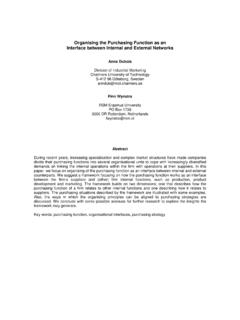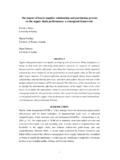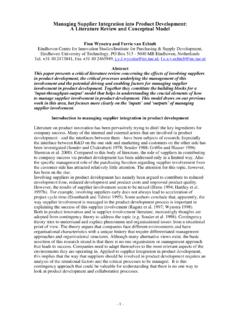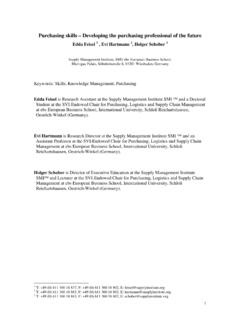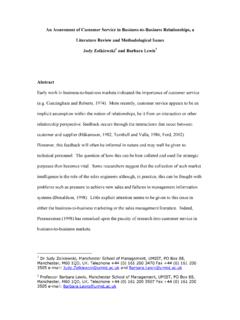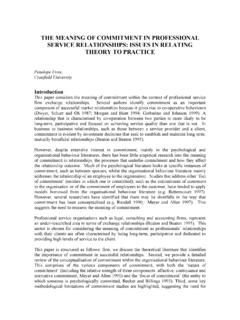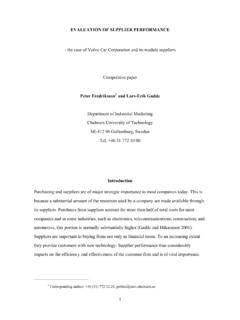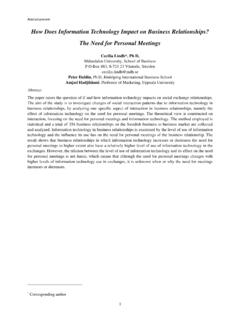Transcription of Supply Risk Assessment - IMP Group
1 Supply Risk Assessment : A Utility value based Concept Aiko Entchelmeier Supply Management Institute SMI , ebs European Business School Soehnleinstr. 8, D-65201 Wiesbaden Germany Dr. Evi Hartmann Supply Management Institute SMI , ebs European Business School Dr. Michael Henke Technical University Munich Abstract Increasing global competition has boosted the pressure on companies to raise corporate performance. To improve profitability more and more companies focus on core-competencies and tend to outsource non-core business activities (Prahalad & Hamel 1990). Following the trend to reduce the degree of value added and to purchase goods and services instead, companies gain competitive advantage by developing relations to other firms (Dyer & Singh 1998). The decision to source large volumes from suppliers however also implies an increasing dependency of the companies from their Supply chains. Poor delivery performance, quality problems and insolvencies of suppliers are just a few threats that companies have to consider when they take purchase decisions.
2 As a consequence companies do not only have to lever performance potentials of purchasing and Supply , they also have to manage the risks that are related to their inbound Supply through a proactive Supply risk management (Smeltzer &. Siferd 1998). In order to understand which characteristics have the greatest effect on risk, Supply managers have to focus their attention on reducing the effect that risk can have on their organization's success and profitability (Zsidisin 2003). Following the old saying you can't manage what you can't measure . (House & Price 1991) a rigorous Supply risk Assessment is necessary to evaluate the effect of Supply risk and to understand the necessity of managerial action. Today quantitative Supply risk assessments are generally conducted by measuring risks as the product of maximum financial damage or loss and the probability of occurrence ( , Harland et al. 2003). An Assessment of Supply risks according to this formula, however, is not always capable to consider the managerial perception of risks (March &.)
3 Shapira 1987) or to depict the impact of risks on a firm's intangible assets (Harland et al. 2003). This paper proposes the incorporation of a Supply risk utility value for the measurement of Supply risks . The concept of the Supply risk utility value is based on cardinal utility theory (von Neumann &. Morgenstern 1947). Utility theory suggests that actors attempt to optimize the expected value of individual preferences defined as utility. It is analyzed how the incorporation of individual preferences into Supply risk Assessment can support the measurement of Supply risks . Furthermore, it is investigated how Supply risk portfolios can be set up with the utility value based Supply risk Assessment concept, how the concept can be used to enlarge the total cost of ownership concept and how utility value based Supply risk metrics can be incorporated into the development of Supply balanced scorecards. Finally, limitations of research and the fields of further research for the Assessment of Supply risks are indicated.
4 Keywords: Supply Risk Management, Supply Risk Assessment , Performance Measurement Introduction and Problem Definition Increasing global competition has boosted the pressure on companies to raise corporate performance. To improve profitability more and more companies focus on core competencies and tend to outsource non-core business activities (Prahalad & Hamel 1990). Following the trend to reduce the degree of value added and to purchase goods and services instead, companies gain competitive advantage by developing relations to other firms (Dyer & Singh 1998). Through the integration of other firms into their value chain companies begin to utilize the core competencies of their value chain partners. The decision to source large volumes from suppliers however, is not always advantageous for companies. It also implies an increasing dependency of the companies from their inbound Supply . Poor delivery performance, quality problems and insolvencies of suppliers are just a few threats that companies have to consider when they take purchase decisions.
5 As a consequence companies do not only have to lever performance potentials of purchasing and Supply , they also have to manage the risks that are related to their inbound Supply through a proactive Supply risk management (Smeltzer & Siferd 1998). To demonstrate the necessity for the development of solutions for the management of Supply risk an example from company practice shall be mentioned: Recently DaimlerChrysler had to stop its production for diesel vehicles for 18 days in the Sindelfingen plant due to a defective diesel fuel injector that has been delivered by its 1st-tier automotive supplier Bosch. As a consequence DaimlerChrysler had to face a collapse in sales because the vehicles could not be delivered to the customers. Daimler claimed that Bosch as the supplier for diesel fuel injectors has been responsible for the losses of the production stop. Bosch on its own stated that the company did not commit any mistakes in the production process and made its American supplier Federal Mogul responsible for delivering sockets with defective coatings for the fuel injector.
6 Federal Mogul also neglected responsibility because it identified granulates for the coating of the sockets from its supplier DuPont as the source of the defective fuel injectors (B schemann 2005). This short example shows that the dependency of inbound Supply and the related risks can be seen as an important issue for companies. Taking into consideration that in some industries like the computer industry and in some areas of the automotive industry the degree of value added has been lowered to less than 25% (Wildemann 2002) risks concerning inbound Supply ( , price risks , currency risks , process interruption risks , fraud risks ) become increasingly important (Zsidisin 2003). and should be managed through Supply risk management. No matter which company in the value chain can be identified as the source of failure, every single participant is obliged to manage its Supply risks in order to reduce the occurrence of hazardous events and thus avoid cutbacks of profits caused by individual supplier failures or the Supply markets.
7 To cover all areas of Supply risk management, a comprehensive Supply risk management system should be implemented (Henke & Jahns 2005; Harland et al. 2003). The course of a risk management system can generally be depicted in the shape of a circle (figure 1). Identifying, analyzing, assessing and managing Supply risks , however, does not mean to solely focus on the functional area of purchasing. Supply risk management has rather to be seen as one of the necessary support processes for the execution of an integral, cross functional Supply process, starting at the source of demand to the fulfillment of the internal customers needs. A comprehensive Supply risk management can only contribute to competitive advantage, when all of its constituting process modules are put into action. One of these modules is Supply risk Assessment . Few purchasing organizations today perform rigorous Supply risk assessments (Zsidisin & Ellram 1999). In literature several frameworks for Supply risk Assessment have been proposed, however, little research has been conducted on investigating the key constructs necessary for Supply risk Assessment (Zsidisin, 2004).
8 Therefore the purpose of this paper is to investigate how Supply risks can be assessed. Firstly lacks in current Supply risk Assessment practice are analyzed and a utility- value based measurement approach ( Supply risk value ) is developed. Secondly the role of the Supply risk value in Supply portfolios, its role as an element of an extended total cost of ownership approach and its use as a key performance indicator (KPI) in Supply balanced scorecards is discussed. Finally, limitations of research and the fields of further research are indicated. 1. Supply Risk Strategy Definition and Revision Comparision of Supply Risk Situation with Design of Supply Risk Supply Risk Strategy Management Analysis of Supply Risk Integrated Supply Supply Risk Situation of the company Risk Management Identification Supply Risk Supply Risk Analysis Management Supply Risk Assessment Figure 1: The integrated Supply risk management process. (adapted from Henke & Jahns 2005).
9 Supply Risk Assessment A Criticism in Current Assessment Practices To understand which characteristics have the greatest effect on risk, Supply managers have to focus their attention on reducing the effect that risk can have on their organization's success and profitability (Zsidisin 2003). Supply risk Assessment evaluates the effect of risks on the companies' performance. Following the old saying you can't manage what you can't measure (House & Price, 1991) a rigorous Supply risk Assessment is necessary to evaluate the effects of Supply risk and to indicate the necessity of managerial action. Supply risk Assessment is a prerequisite for the management of Supply risks . Decisions on the management of Supply risks can only be taken when the impact of risks on the company's business can be evaluated. Today quantitative Supply risk assessments are generally conducted by measuring the average risk value (ARV) of a risk (i) as the product of the maximum financial damage or loss (l) and the probability of occurrence (p) ( Harland et al.)
10 2003): ARVi = li pi (1). An Assessment of Supply risks according to Formula 1, however has been discussed in scholarly literature. Henke & Jahns (2005) argue that the calculation of the average risk value lacks of a strategic factor. As an example the authors refer to the risk calculation of the maximum credible accident in a nuclear power plant. Although the probability of an accident is very low, the damage would be severely high if the unlikely event of a hazardous incident would occur. They argue that the average risk value would not differentiate this event from events where the damage is very low but the corresponding risk of occurrence is very high ( , when a contract in the c-part delivery of a production line is broken). Henke & Jahns (2005) conclude that an average risk value for both events could be similar even though the consequences for management would be totally different. Therefore they propose to enlarge Supply risk Assessment by taking decisive measures ( key performance indicators) into account.
